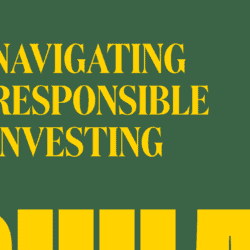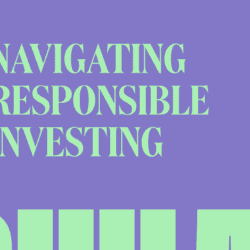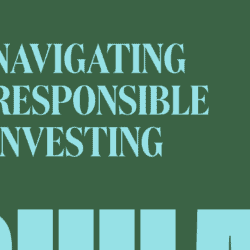Canadian foundations know that responsible investing can reap both positive impacts and benchmark-beating financial returns, but it isn’t easy – knowing where to invest, measuring social outcomes, even agreeing what to call it. It’s “tough, ongoing work,” says one foundation leader.
When the Atkinson Foundation approached the TMX Group Ltd. with a bold shareholder proposal on Indigenous inclusion, the Toronto-based corporation had a polite, but firm, response.
Thank you, but no.
“It was a hard sell,” Colette Murphy, CEO of the Atkinson Foundation, recalled recently.
There was uneasiness at the board of the operator of the country’s largest stock exchange. It wasn’t sure whether it could deliver on the Atkinson proposal. It wasn’t even sure exactly what it was being asked to do. The Toronto Stock Exchange, after all, was not the type of business usually associated with reconciliation.
Murphy was working through the Reconciliation and Responsible Investing Initiative, a partnership between the National Aboriginal Trust Officers Association (NATOA) and the Shareholder Association for Research and Education (SHARE), which aims to further reconciliation. In this case it was focusing specifically on Recommendation 92 of the Truth and Reconciliation Commission’s calls to action, which seeks to engage the corporate sector on reconciliation.
There are material risks for companies that do not address [responsible investing] issues. It has an effect on the bottom line.
Colette Murphy, Atkinson Foundation
Undeterred, Murphy persisted. A dialogue continued that included Shannon Rohan, chief strategy officer at SHARE, which works with Atkinson and other foundations as well as institutional investors to steward their investments into social action.
“There was a lot of hard work back and forth,” Murphy says. “We used sound business expectations.” She argued that we are in an era when responsible investing is not just a nice thing to do but that “there are material risks for companies that do not address these issues. It has an effect on the bottom line.”
“We educated,” Rohan says. “We shared a perspective the company may not have been exposed to in its day-to-day dealings or internally from its own shareholders or board. Part of that was sharing the possibilities. There was a moment during our discussions when the TMX started to think, ‘You know, you’re right,’ and as the owner of the Toronto Stock Exchange, with its ability to raise capital and profile what other companies were doing in this realm, they had an important role.”
TMX CEO John McKenzie is credited by all involved for a progressive outlook, but it was hard work that ultimately led to 98% shareholder support for the Atkinson proposal. History was made, with Atkinson, as an activist investor in the TMX, mobilizing shareholders and acting as a catalyst to shape the behaviour of capital markets.
Reconciliation is now on the agenda of corporate Canada in a way it really hasn’t been in a meaningful way in the past.
John McKenzie, TMX Group
It was the first time a resolution on Indigenous inclusion had been accepted by the board of directors at a Canadian company. TMX committed to developing internal equity-and-inclusion programs and reviewing its policy on procurement from Indigenous-led companies. Crucially, it agreed to list publicly traded companies that have received the Progressive Aboriginal Relations (PAR) certification, giving investors a go-to guide to companies that have received that approval after an analysis of 52 criteria under four pillars on inclusion and reconciliation established by the Canadian Council for Aboriginal Business (CCAB). The TMX agreement is already having a cascading effect on capital markets and reconciliation.
“Indigenous reconciliation is now on the agenda of corporate Canada in a way it really hasn’t been in a meaningful way in the past,” McKenzie told a panel discussion last spring (his office did not make him available for this article).
“When they stepped up, they provided leadership to other public companies,” Murphy says.
There are nine PAR-certified companies listed on the TMX and 12 that are committed to PAR values.
The listings became a reality thanks to a call, arranged by SHARE, between Tabatha Bull, the president and CEO of the CCAB, and McKenzie.
More and more now we hear from investors and shareholders about where they should invest their money.
Tabatha Bull, Canadian Council for Aboriginal Business
“It’s always been kind of a dream of mine if we could have PAR-certified organizations on the [TMX] listings so if you’re an investor and you want to invest with a business that is doing good work with Indigenous communities, people can see immediately what companies are certified,” Bull says.
McKenzie told her he didn’t see why that would be difficult. “More and more now we hear from investors and shareholders about where they should invest their money,” Bull says. “This has moved the dial.”
When one looks at the TMX success and the rise of responsible investing, one comes back to a question raised earlier in this series by Allan Northcott, president of Max Bell Foundation: if a foundation can generate positive social impacts with returns at least comparable to status quo investing, “well, why wouldn’t you?”
There are speed bumps strewn along the path to increased responsible investing, some of them real, some of them outdated, some of them largely imagined.
There are many answers to that question, the first being the most basic: it’s not easy. In fact, the sector and other institutional investors can’t even agree what to call it: responsible investing, impact investing, or ESG investing – generally defined as investments that measure environmental, social, and governance factors when determining the ethical or sustainable impact of a business. The Global Impact Investing Network (GIIN) defines impact investments as “investments made with the intention to generate positive, measurable social and environmental impact alongside a financial return.”
There are speed bumps strewn along the path to increased responsible investing, some of them real, some of them outdated, some of them largely imagined. There is a fear that financial returns will be sacrificed. There is a slow transition from more traditional asset managers who may have made money in the oil and gas sector to less risk-averse managers. There is the belief that metrics do not exist to help with successful investments and the fear that ESG ratings are being gamed. “Greenwashing,” the act of issuing misleading or downright false claims on environmental performance, is real. And there is a politically motivated pushback against what the U.S. right has taken to calling “woke” investing, the false claim that an emphasis on social good is hurting investors. There are fears it may leak north of the border.
As of January 2023, 5% of our money is mandated to go out the door. The question is, what are we doing with the other 95%?
Colette Murphy
According to Imagine Canada, Canadian foundations are sitting on $116 billion in assets. “With $116 billion there is power,” Murphy says. “As of January 2023, 5% of our money is mandated to go out the door. The question is, what are we doing with the other 95%?”
All Atkinson investments are aligned with its values of reconciliation and respectful, equitable treatment of workers, but it is also prepared to add its voice to issues of climate, justice, democratic governance, and a fairer economy.
“We know real progress can be made on responsible investing because we’ve seen it with our own eyes at different times on several issues over the past 20 years,” Murphy says. “We’re in it for the long-term. We are not driven by quarterly results.”
Investments can be powerful tools to achieve and accelerate charities’ visions and missions and create positive impact beyond financial returns.
Senator Ratna Omidvar and Aatif Baskanderi, Northpine Foundation
In a recent Philanthropist op-ed, Senator Ratna Omidvar and Aatif Baskanderi, president of the Northpine Foundation, argued that, at minimum, investments from foundations must not undermine the charity’s vision, mission, and values, or the work of grantees they support.
“But . . . they can be powerful tools to achieve and accelerate charities’ visions and missions and create positive impact beyond financial returns,” they wrote. They argue that foundations can do more and that there is a role for government to nudge them in that direction through policy.
But even without that nudge, Canadian foundations know that responsible investing can reap positive financial returns.
Inspirit Foundation, only eight years old, now has 100% of its $40 million in impact investing and is beating traditional financial benchmarks while aligning with its mission of addressing discrimination based on race, ethnicity, or religion.
Jory Cohen, the foundation’s director of finance and impact investment, became interested in impact investing after reading Banker to the Poor, the autobiography of Nobel Peace Prize winner Muhammad Yunus, which his mother had given him as a birthday present before he entered London’s Ivey Business School.
We have found that not only are we not sacrificing financial returns, we are beating benchmarks. It has been true in the long-term and the short-term.
Jory Cohen, Inspirit Foundation
“I approached my studies through that lens. It was eye-opening for me,” he says.
Inspirit’s investment portfolio is based on companies that earn the majority of their revenues in line with the United Nations Sustainable Development Goals. “We have found that not only are we not sacrificing financial returns, we are beating benchmarks. It has been true in the long-term and the short-term,” Cohen says.
Marcel Lauzière, president and CEO of the Lawson Foundation, a fifth-generation family foundation, began impact investing in 2014, willing to take some risks and accept below-market returns. It hasn’t happened. Over a basket of 12 impact investments, returns have ranged from 3.5 to 12%.
When he started, impact investment targets were slim, so he broadened his investments beyond Lawson’s mission of work with children and youth and moved into affordable housing and the environment. Early on, Lauzière teamed with an informal group of about 10 foundations because the same investees were knocking on the same doors. He does not use asset managers but works with Impact United to exercise due diligence on prospective investments.
The sector has had studies at their fingertips for some time. A 2015 Carleton study found that socially responsible mutual funds outperformed financial benchmarks 63% of the time. A larger, more recent study by the NYU Stern Center for Sustainable Business also showed that the majority (58%) of ESG funds outperformed traditional, status quo investment.
The Russian invasion of Ukraine has led to an uptick in the value of investments that are contrary to impact investing aims, such as oil and gas and weapons manufacturing. Regardless, impact investing has weathered a down year for all investors better than traditional investors. According to the U.S.-based financial services firm Morningstar, the value of global sustainable assets fell 13.3% from the first quarter to the second quarter of 2022, but that was still better than the 14.6% drop in the market overall.
I’ve never been a believer that there is this magic bullet, or something is going to fall from the sky and it will tell us how to measure social outcomes. It is very, very difficult to do.
Marcel Lauzière, Lawson Foundation
And this, perhaps short-term, setback comes amidst another widespread concern. How does one know where to invest? Where are metrics or the taxonomy to define “impact”? The question has been asked for years, but the lack of what Rohan calls “The North Star” for investors is no reason for hesitancy, many in the sector agree.
“I’ve never been a believer that there is this magic bullet, or something is going to fall from the sky and it will tell us how to measure social outcomes,” Lauzière says. “It is very, very difficult to do.”
Tim Nash, an advisor on sustainable investing and the founder of Good Investing, agrees that investment criteria can be “a little fuzzy … I don’t think we’re ever going to get 100% clarity on this. Every financial manager today uses his or her own metrics, so responsible investing is no different. We want diversity in our approach. I don’t know how helpful it would be to have one clear definition.”
The success of responsible investing rests with our ability to move beyond traditional approaches and drive a complete rethink about how investors look at risk, opportunity, and their role in this system.
Shannon Rohan, Shareholder Association for Research and Education
Rohan says responsible investing is more art than science: “We need to be wary in this investment industry of oversimplification. We don’t want this to become an exercise in ticking boxes. We like when things are neat and tidy, but ESG is complex and multi-faceted. The success of responsible investing rests with our ability to move beyond traditional approaches and drive a complete rethink about how investors look at risk, opportunity, and their role in this system.”
Would-be responsible investors are also facing potential political pushback, already in play in the United States, and increasing concern about and awareness of “greenwashing.”
In August, 19 Republican attorneys-general in the U.S. opened fire on BlackRock Inc., the giant asset manager, saying they would “not idly stand for our pensioners’ retirements to be sacrificed for BlackRock’s climate agenda.”
BlackRock responded, saying companies that have a progressive climate-change position will provide better financial returns. But the likes of Mike Pence and Elon Musk have joined the chorus against “woke investing,” and Canadian foundations are watching, warily.
It may be “outrage politics,” Nash says, but ESG investing is an inviting target for the political right. “It is a complex notion, and the right can mould the narrative with the ‘Go woke, stay broke’ slogan.” Although the position is demonstrably wrong, Nash warns that Americans have in the past bought into a simplistic argument, on critical race theory for example, without actually looking at the issues.
Eugene Ellmen, a pioneer in responsible investing and the former executive director of the Canadian Social Investment Organization (now the Responsible Investment Organization), says the sector is creating an opening for political enemies. “By failing to be clear on what it is trying to do with ESG, it is leaving itself open to these ludicrous attacks from the right.”
He said asset managers must be clear and transparent on the true accomplishments from impact investing. “Lack of clarity makes them vulnerable to attacks,” he says. “We have to be vigilant.”
Rohan has a different take. She believes that “the rubber is hitting the road” and that investors are pressuring companies for climate change action now with measurable results. These companies are feeling the heat and seeking political cover, she says.
The immediate threat to responsible investing, most notably ESG investing, is the concern over “greenwashing,” at a time when companies have become adept at raising their ESG scores and ratings firms are accused of generating scores based on environmental threats to a company’s bottom line, rather than the company’s environmental performance. In December 2021, Bloomberg rocked the responsible investing community with an exhaustive piece entitled “The ESG Mirage.” It found, among other revelations, that the giant ratings agency MSCI upped the ESG rating of McDonald’s while the fast food giant’s carbon emissions in 2019 exceeded those of Portugal. MSCI removed carbon emissions from its analysis of McDonald’s and instead gave the company credit for installing recycling bins.
“There is fair criticism of ESG as an investment tool,” Cohen says. “Companies these days are adept at generating high ESG scores, whether they are deserved or not.” Many just don’t pass the eye test, he says, and are “cringeworthy” when it comes to their social and environmental impact. The philanthropic sector must move beyond ESG ratings and ask itself what the company actually does and whether their products and services are a core part of the solution.
“If you don’t do that, then criticism is very fair,” he says.
Impact investing is the future of what we will see from foundations.
Jory Cohen
Ultimately, impact investing takes a lot more attention and effort than traditional investing, Cohen says, but he firmly believes this is something foundations should be doing with their entire portfolio. “This is the future of what we will see from foundations.”
Lauzière concurs and warns against an easy way to reach impact investing goals.
“It’s not just a matter of ‘do ESG and everything will be fine,’” he says. “It is not always easy to just invest in something and get the return you want. This is really tough, ongoing work.” But, he says, it is work worth doing.
More needs to be done, Bull says, when it comes to lifting up Indigenous-led businesses. Those businesses are as concerned with social impact and giving back to their communities as they are with profits, “and they need to find investors who are looking to invest in social impact. There is a lot of growth potential in Indigenous businesses.”
Ellmen warns the sector that ESG ratings are often being used as risk management tools for companies when they are taking no real action to get to climate targets or other social goals.
But he and others feel the impact investing train has left the station, and despite the extra work needed, it will become the norm in the philanthropic sector.
“Nobody’s got it right yet,” he says. “Nobody’s got a perfectly green portfolio. The whole world is struggling with these issues.”
***
Divest or invest? Is it more effective to eliminate fossil fuels from your portfolio or invest in high emitters and push them in transition to a greener future? That debate will be explored in a future article.


